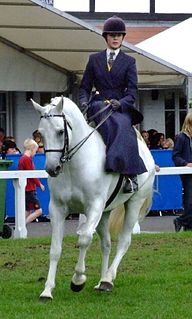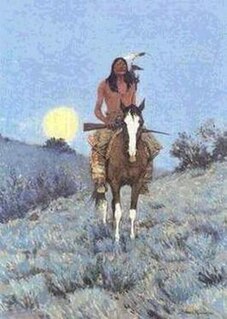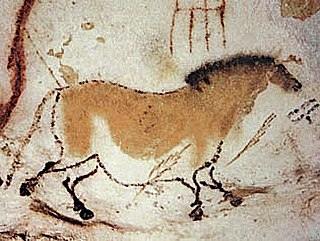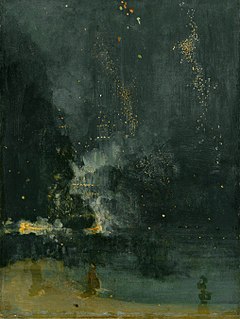
A cowboy is an animal herder who tends cattle on ranches in North America, traditionally on horseback, and often performs a multitude of other ranch-related tasks. The historic American cowboy of the late 19th century arose from the vaquero traditions of northern Mexico and became a figure of special significance and legend. A subtype, called a wrangler, specifically tends the horses used to work cattle. In addition to ranch work, some cowboys work for or participate in rodeos. Cowgirls, first defined as such in the late 19th century, had a less-well documented historical role, but in the modern world work at identical tasks and have obtained considerable respect for their achievements. Cattle handlers in many other parts of the world, particularly South America and Australia, perform work similar to the cowboy.

Horses can use various gaits during locomotion across solid ground, either naturally or as a result of specialized training by humans.

Frederic Sackrider Remington was an American painter, illustrator, sculptor, and writer who specialized in the genre of Western American Art. His works are known for depicting the Western United States in the last quarter of the 19th century and featuring such images as cowboys, American Indians, and the US Cavalry.

Chaps are sturdy coverings for the legs consisting of leggings and a belt. They are buckled on over trousers with the chaps' integrated belt, but unlike trousers, they have no seat and are not joined at the crotch. They are designed to provide protection for the legs and are usually made of leather or a leather-like material. Their name is a shortened version of the Spanish word chaparreras. Chaparreras were named after the chaparral from which they were designed to protect the legs while riding on horseback. Like much of western horse culture, the origin of chaparreras was in the south of Spain, from which it then passed on to the part of New Spain that later became Mexico, and has been assimilated into cowboy culture of the American west. They are a protective garment to be used when riding a horse through brushy terrain. In the modern world, they are worn for both practical work purposes and for exhibition or show use. Chaps have also been adopted for use on motorcycles, particularly by cruiser-style motorcycle riders.

Classical dressage evolved from cavalry movements and training for the battlefield, and has since developed into the competitive dressage seen today. Classical riding is the art of riding in harmony with, rather than against, the horse.

Sidesaddle riding is a form of equestrianism that uses a type of saddle which allows a rider to sit aside rather than astride an equine. Sitting aside dates back to antiquity and developed in European countries in the Middle Ages as a way for women in skirts to ride a horse in a modest fashion while also wearing fine clothing. It has retained a specialty niche even in the modern world.
A singing cowboy was a subtype of the archetypal cowboy hero of early Western films. It references real-world campfire side ballads in the American frontier, the original cowboys sang of life on the trail with all the challenges, hardships, and dangers encountered while pushing cattle for miles up the trails and across the prairies. This continues with modern vaquero traditions and within the genre of Western music, and its related New Mexico, Red Dirt, Tejano, and Texas country music styles. A number of songs have been written and made famous by groups like the Sons of the Pioneers and Riders in the Sky and individual performers such as Gene Autry, Roy Rogers, Tex Ritter, Bob Baker and other "singing cowboys". Singing in the wrangler style, these entertainers have served to preserve the cowboy as a unique American hero.

Frederic Remington: The Truth of Other Days is a 1991 documentary film of American Western artist Frederic Remington made for the PBS series American Masters. It was produced and directed by Tom Neff and written by Neff and Louise LeQuire. Actor Gregory Peck narrated the film and Ned Beatty was the voice of Remington when reading his correspondence.

Horseland is an American animated series produced by DIC Entertainment Corporation. It is a comic mischief program following events in the lives of a group of children riding at Horseland, an equestrian school and stables. Their adventures include riding their horses and entering them in competitions to test their skill and friendships. The show premiered on September 16, 2006, as part of CBS's new Saturday morning cartoon block, KOL Secret Slumber Party on CBS later KEWLopolis. Concurrent with the series, the online virtual pet game that it was based upon was updated to complement the show by launching a new "Junior version" of the game based on the program and featuring its various characters and locations. After three seasons, the show was canceled on CBS on December 6, 2008. Reruns of Horseland then aired nationwide on the digital subchannel This TV; two episodes aired each weekend until September 2010. Horseland last aired as part of Cookie Jar TV on CBS. It has 7 books for the series related to the episodes which are available to be purchased online.

The jumping position is a position used by equestrians when jumping over an obstacle. It usually involves what is known as the "forward seat" or "2 point" because the rider's legs provide two points over which the rider's weight is balanced on the horse. It was first developed by Captain Federico Caprilli. This involves the rider being centered over his or her feet, with the stirrup leathers perpendicular to the ground. Continuing a line upwards from the stirrup leathers, the head and shoulders fall in front of the line, as do the knees and the hips fall behind it.

Horses have appeared in works of art throughout history, frequently as depictions of the horse in battle. The horse appears less frequently in modern art, partly because the horse is no longer significant either as a mode of transportation or as an implement of war. Most modern representations are of famous contemporary horses, artwork associated with horse racing, or artwork associated with the historic cowboy or Native American tradition of the American West. In the United Kingdom, depictions of fox hunting and nostalgic rural scenes involving horses continue to be made.

Jay Wilsey was an American film actor. He appeared in nearly 100 films between 1924 and 1944. He starred in a series of very low-budget westerns in the 1920s and 1930s, billed as Buffalo Bill Jr.

"Skin and Bones", also stylized as "Skin & Bones", is the eighth episode in the television series Fear Itself on NBC. The plot revolves around a man who becomes possessed by a Wendigo.

Nocturne painting is a term coined by James Abbott McNeill Whistler to describe a painting style that depicts scenes evocative of the night or subjects as they appear in a veil of light, in twilight, or in the absence of direct light. In a broader usage, the term has come to refer to any painting of a night scene, or night-piece, such as Rembrandt's The Night Watch.
Olaf Wieghorst was a Danish-American painter who specialized in depictions of the American frontier. His art was in the vein of Frederic Remington and Charles Russell. In 1992, he was inducted into the Hall of Great Westerners of the National Cowboy & Western Heritage Museum.
Dan Muller aka Daniel Cody Muller (1889–1976), artist, illustrator and writer of the American West; Muller was born in Choteau, Montana, October 11, 1889 to Carl and Augusta Muller.

The Early Bird Dood It! is a 1942 MGM cartoon directed by Tex Avery and produced by Fred Quimby. The composer of this cartoon was Scott Bradley.

The Rattlesnake is an equestrian sculpture by American artist Frederic Remington. The bronze sculpture was one of Remington's most popular, after The Broncho Buster, and it has been described as Remington's own favorite sculpture.

Fired On is a 1907 oil painting by Frederic Remington. It measures 68.8 cm × 101.6 cm and has been held by the Smithsonian American Art Museum since 1910.
Western American Art includes artistic work which depicts the subjects related to the Western American region, and was treated as impoverished, unwanted and unworthy art before the twentieth century, during which period it achieved respectability as a rewarding region for studying. The term holds a characteristic of narration that is different from the Modern art which focuses on abstraction. For the narration, Western American art focuses on subject than style. Considering as a national art, the subjects are distinct from the European art, namely, there is no elements from other region like Europe. Cowboys and Indians are two well-known subjects and they consist the important part of artistic work of Western American art, demonstrating the daily life and activities of cowboys and American Indian in western American.
















